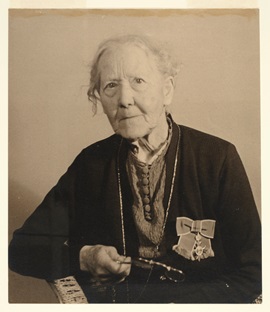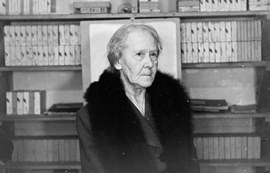Nurse, historical researcher, indexer, honorary archivist

Early Life
Miss Amelia Lucy Wayn was born in Coblentz, Germany, the daughter of the Reverend Arthur Wayn, an Anglican clergyman, and his wife Amelia, nee Ibbotson, who came to Tasmania in 1864. Her mother died in 1877, leaving a young family, and Amelia accompanied her father around the various parishes in which he was incumbent. After her father’s retirement, Miss Wayn trained as a nurse at the Launceston Public Hospital from 1896-1899 under Dr John (later Sir) Ramsay and Dr Drake.
After a period in England, where she gained a certificate for massage, she settled in Hobart. Here she conducted the Fairfield Private Hospital in Campbell Street, in partnership with Matron Moore-Robinson in the early 1900s. Matron Moore-Robinson (nee Augusta Isabel McDowall) had also trained at the Launceston Public Hospital, so she and Lucy may well have known each other through this avenue.
War Service
Amelia enlisted for service in the Australian Army Nursing Service in June 1915. Her age probably prevented her from overseas’ duties as she was posted to hospitals in the No 6 Military District (Tasmania). She was appointed as the Sister-in-Charge at the Roseneath Military Hospital where Mrs Moore-Robinson was the Matron, and then, in 1918, to the Military Hospital in Launceston (Hornsey Hospital) where she was the Matron.
From the Weekly Courier:
“Matrons Curtain, Wayne [sic], and Carpenter have supervised the hospital and nursing staff, and the genuine and wholehearted respect shown by the boys has proved each of these ladies a true foster mother to her large family of “Diggers”. Especially worthy of mention were their efforts to alleviate what necessarily became a monotonous routine by inaugurating concerts and card parties during the summer and dances in the winter evenings”
A palmist-patient once told Amelia she should be among papers, not patients.
Amelia was demobilised on 18 December 1920.

Post war
In the 1920s Amelia was employed as an Indexer by John Moore-Robinson, Librarian-Publicity Officer in the Chief Secretary’s Department and continued as Honorary Archivist until a permanent Archivist was appointed in the late 1940s.
She gave valuable service in compiling an index to the contents of early Tasmanian newspapers up to about 1856, and also the inward and outward Government Despatches which were held in the Chief Secretary’s Office.
In the 1920s Amelia was employed as an Indexer by John Moore-Robinson, Librarian-Publicity Officer in the Chief Secretary’s Department and continued as Honorary Archivist until a permanent Archivist was appointed in the late 1940s.
She gave valuable service in compiling an index to the contents of early Tasmanian newspapers up to about 1856, and also the inward and outward Government Despatches which were held in the Chief Secretary’s Office.
The Index to Tasmanian Government Records and Colonial Newspapers (Wayn Index) has proved a treasure-house of information to investigators into early Tasmanian history, and its detail is unrivalled in the Commonwealth. Amelia had no assistants, not even a typist, and the cards in her index system are filled with her own writing, which has something of the Old World in its style.
Amelia also compiled indexes on more specific topics including Lists of Public Officers and various passenger lists. More details on these indexes are available here.
Although she did not publish any books herself, Amelia contributed greatly to the work of others through the provision of information, research and assistance.
Amelia created many research notes for Wilfred Hugh Hudspeth, an amateur Historian and Trustee of the Museum who wrote many works on Tasmania. The Series NS690 W H Hudspeth’s Historical Files – contains notes compiled for Mr Hudspeth by Amelia.
Amelia also created a small number of manuscripts which are held in the WL Crowther Library.
In 1941, Amelia was awarded an Order of the British Empire – Member (Civil) for public service in Tasmania. Amelia continued her indexing and research up until 1949, when a full-time archivist was appointed. The massive indexes and compilations that she created are held in the Tasmanian Archive and Heritage Office and are a lasting memorial of her work.
Amelia was one of the foundation members of the Australasian Trained Nurses’ Association which was formed in late 1908.
She was also an enthusiastic charity worker, spending much of her leisure time knitting scarves for leper colonies throughout the world.
Amelia died in Hobart on 11 August 1951 and was cremated at Cornelian Bay.
She was admitted to the Tasmanian Honour Roll for Women in 2009 for services to Cultural Heritage.
References
- Ian Pearce ‘Wayn, Amelia Lucy (1862–1951)’, Australian Dictionary of Biography, National Centre of Biography, Australian National University, accessed 22 April 2015.
- Research file Tasmanian Archives History Room
- Mercury, 29 October 1915, p. 8
- Examiner, 3 June 1918, p. 3
- Weekly Courier, 26 February 1920, p. 17-19 (photos), p. 36 (Text)
- Argus, 27 March 1945, p. 7
- Mercury, 14 August 1951, p. 13
- Express, 8 August 1964, p. 8
- Effecting a cure: aspects of health and medicine in Launceston, edited by Paul A.C. Richards, Barbara Valentine and Tome Dunning, Launceston, Myola House of Publishing, c.2006, p. 484-487

